200 Search Results for video assessment
July 8, 2014
by Carole Zangari -
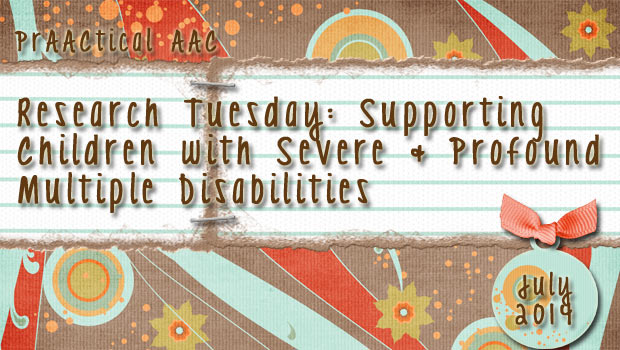
What do we know about the best ways to provide communication support to individuals with severe and profound multiple disabilities (PMLD)? PMLD is a term that generally refers to people who experience profound cognitive limitations in addition to sensory and/or physical disabilities. Many of these individuals have complex medical histories and chronic health concerns. Often, the communication difficulties experienced by individuals with PMLD cause them to be isolated and excluded from many social and educational opportunities. Despite their many challenges, there is evidence to suggest that AAC supports can help these children develop their communication skills. Not much is known, however, about how to structure the AAC intervention to maximize learning. In this study, Harding and her colleagues sought to reduce isolation and promote personal autonomy by providing AAC supports to two children with PMLD. As other researchers have demonstrated the positive impact of AAC on people with PMLD,... [Read More...]
June 28, 2014
by Carole Zangari -
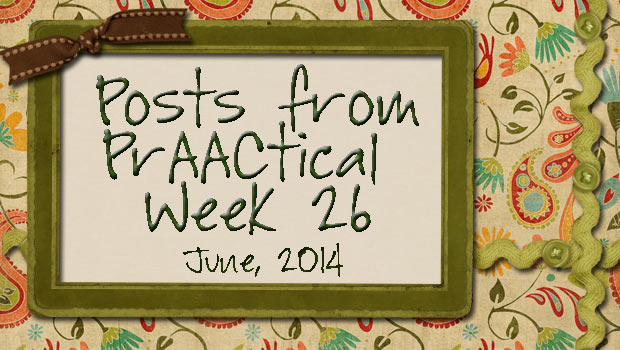
Sunday: Video of the Week – A Light-hearted Approach to Making People Comfortable with AAC Monday: Strategy of the Month – Building Sentence Length Through Conversational Routines and Games Tuesday: PrAACtical Resources: Developing Skills for Switch Use Wednesday: Watch It Wednesday – Client Priorities Drive AAC Assessment Recommendations Thursday: PrAACtically Reading with Brown Bear Friday: Learning How to Swim: On Being a New SLP Graduate in the Field of AAC
March 22, 2014
by Carole Zangari -
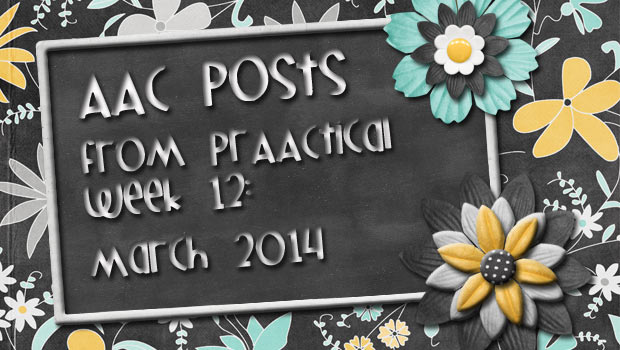
It’s prAACtically spring in much of North America! To all of our friends who suffered through a c-r-a-z-y winter: You made it!! Here’s what we’ve been up to. Sunday: Video of the Week – A Right to Communicate Monday: Strategy of the Month – Building Communication Skills During Storybook Reading Tuesday: Teach Me Tuesday – Predictable App Wednesday: On Communication and Behavior – Back to Basics Thursday: AACtual Therapy with Jeanne Tuthill – An AAC Assessment Activity Friday: 5 Resources for Creating AAC and Visual Support Materials
February 10, 2014
by Carole Zangari -
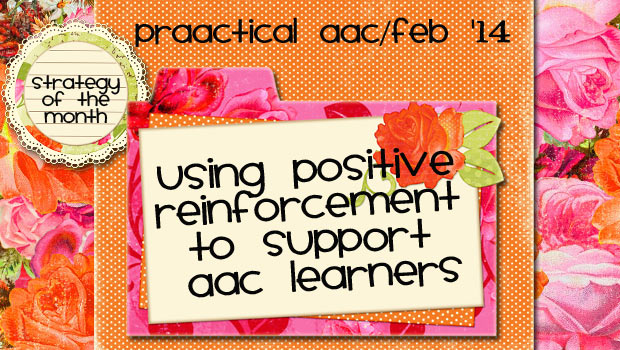
In terms of reinforcement, Jamie kept me on my toes. Initially, she preferred to be by herself so that she could do her own thing without any demands placed on her. Solitary time is not our favorite way to reinforce desired behavior, but it was a start. Jamie earned little bits of free time where she could have some uninterrupted play. Then, she seemed to like anything that she could line up. No sweat. (This is progress! We were much happier to see her desire things as opposed to the absence of company. We had lots of things that we could use and she loved the novelty of materials we presented…for short awhile). Quickly, that morphed into things that she could line up that had letters. Got it! (We can repurpose some alphabet puzzles/games and we’re good!). Then, things got interesting. One week there was an intense love of... [Read More...]
December 7, 2013
by Carole Zangari -
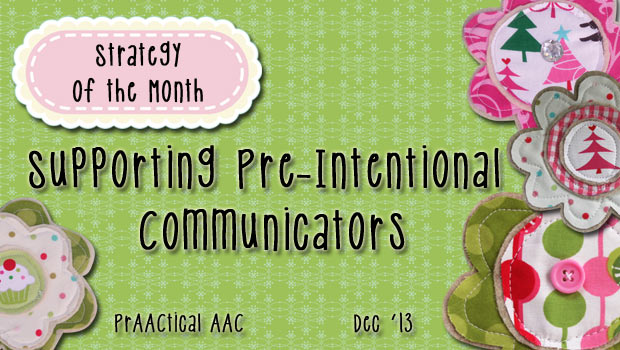
Scene 1 Alex looks at the picture symbol choices placed in front of him and knocks them to the floor. Simone looks distressed while she waits for her lunch and whines as she watches her classmates eating. Jason smiles engagingly and rocks enthusiastically when his favorite aide enters the room. Kyra takes a picture from her PECS book and begins to chew on it. Scene 2 “He can’t even make choices. I’m not even sure what he wants.” “She really doesn’t communicate.” “He doesn’t mean anything by it. He does that all the time.” “She needs hand-over-hand prompting for everything.” Great kids, caring professionals. Ineffective communication. This month, we focus on ways to support children and adults at the earliest stages of communication. It isn’t easy trying to figure out how to provide effective SLP services to individuals who are not yet sending messages intentionally. Communicators at the pre-intentional level are... [Read More...]
December 2, 2013
by Robin Parker -
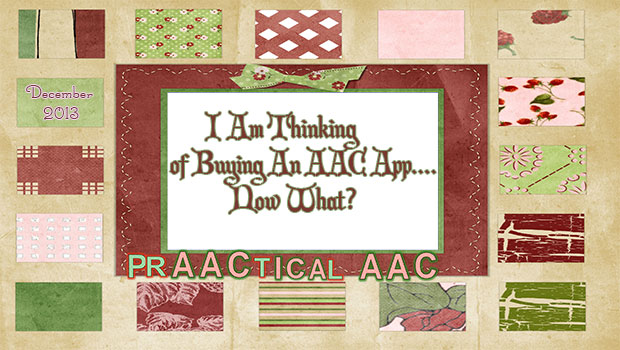
This may be the time of year you are thinking of adding AAC apps to your assessment collection or are planning on getting one for an individual learner or for a group of learners. As you consider which app or apps to purchase, here are some feature considerations as well as some options for learning about the apps. **For any individual learner, a specific AAC evaluation by a qualified speech-language pathologist is always highly recommended. Language Features Core word approach to language learning Functional language approach to language learning Visual scene approach to language learning Pre-made communication displays or create your own Communication Functions (requesting, Choicemaking, commenting, complaining, etc.) Sentence building options Options for morphological learning Allows for full communication including requests, saying no, greetings,ventings, and sharing of information Comprehensive language learning Small Talk Single or sequenced messages Technical Features Customization level Platform Options (iOS, Android, Computer) Digitized (recorded) vs... [Read More...]
October 31, 2013
by Robin Parker -
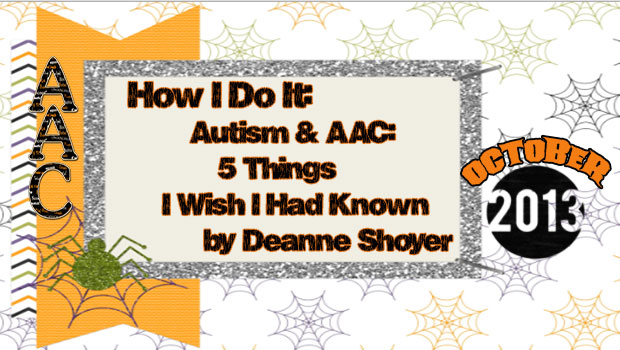
We are so pleased to have connected with Deanne Shoyer from Small But Kinda Mighty and even happier that she is our guest blogger today. Deanne is a mom of twin boys who both are on the autism spectrum. Deanne successfully fundraised to buy iPads for her boys and has been active for more than 3 years in social media and in the special needs app community. She has written about many things but often focuses on implementing AAC in a very PrAACtical way. Please feel free to share this very important post as she highlights AAC, what she has learned, and how it may help others. by Deanne Shoyer at Small But Kinda Mighty (original post at Small But Kinda Mighty) In the title of this post I’ve linked autism and AAC for a specific reason. A lot of the points here are equally applicable to people who have a... [Read More...]
September 7, 2013
by Carole Zangari -
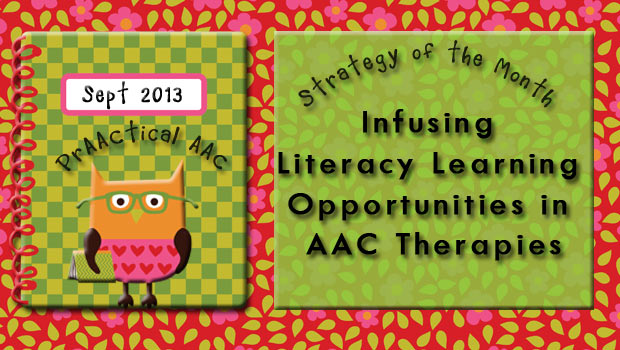
Most of our conversations with SLPs about teaching literacy to individuals with AAC needs revolve around the ‘How’s.” “How can I possibly teach reading and writing? I don’t have enough time with her to teach language and communication!” “How am I going to teach reading to someone who can’t sound out words? Or writing to someone who can barely use a pencil or keyboard?” In general, SLPs WANT to teach literacy skills. They understand the importance of this skill set and how it can level the playing field for people with communication difficulties. They know that reading and writing are inherently linked to speaking and listening. They know that literacy is a powerful key that unlocks many, many doors. And yet, getting from there to the point of actually teaching clients with AAC needs to read and write is not something we do enough of. This month, we’ll look at ways... [Read More...]
September 4, 2013
by Robin Parker -

Strategy of the Month Back to School with AAC AAC ‘Must Haves’ for the Classroom & Speech Room PrAACtical Partnerships: AAC & Academics AAC Around the School and Beyond Core Words & the Curriculum PrAACtical Thinking 5 Things to Remember About AAC Technology Fun Friday Commenting to the Max 31 Posts You May Have Missed in July Keep Calm & …………. Great Music Apps & AAC Language Goals 5 Free Resources for Making Communication Boards & Visual Supports 5 Reasons to Say Yes to ‘NO’ Magic Moments with Tellagami Watch It Wednesday: AAC Core Word Vocabulary teaching by Gail Tatenhove & Robin 5 Ways to Use Sequenced Message SGDS and APPS 7 Writing Apps & Activities for ALL Writers PrAACtical Uses of QR Codes Watch This: Example of Teaching Expressive Language with the iPad & AAC Device by the Awesome AAC Chicks 5 Things to Consider About Data Collection in... [Read More...]
August 24, 2013
by Robin Parker -
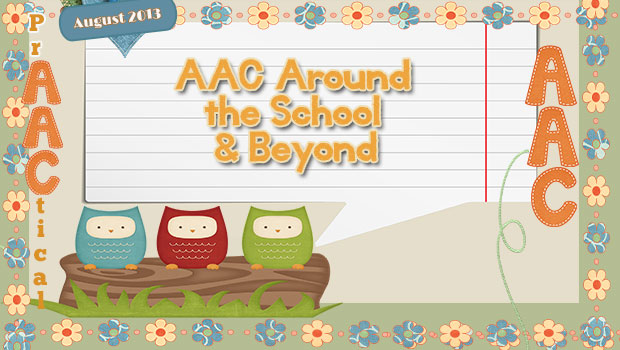
For the August Strategy of the Month, we have been thinking, writing, & talking about AAC in School. School is where AAC learners spend a large portion of their days. There needs to be multiple opportunities for students to USE and LEARN AAC each day. More than that though, we strive for full participation and interaction for students who use AAC. Students should not have to prove that they can do these things before they have ACCESS to AAC strategies and intervention. Here are some things that can be done to help build AAC participation for both students and educators. Provide ACCESS to AAC devices and visual supports throughout ALL activities in ALL places in school and on school sponsored trips/community based instruction. Provide Aided Language Input when teaching AAC to students. Use a Core Word approach when teaching AAC to students but don’t forget about Fringe Vocabulary. Learn and use partner assisted communication... [Read More...]









